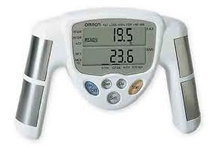Measuring body composition (what you’re made up of) can be pretty important when assessing your health and physical fitness. There’s quite a few ways it can be done, but what’s the best? Here I’ll quickly run through a few options, what’s good about them and what’s not so good!
Body Mass Index (BMI)
This seems to be an NHS favourite. It’s a measure of your weight relative to your height. A graph has been put together so you can see what category you fall into (ranging form underweight to class 3 obese). BMI is used a lot in large studies to assess people’s risk of developing conditions such as heart disease or type 2 diabetes. It’s certainly handy for this, but what about someone who’s lean or athletic? The last time I got this measured in the hospital I fell into the pre-obese category. So for a lot of people, not such a good measure.
Skin Fold Calipers
This method uses little clipper like things called calipers. The theory implies that pinching and measuring the amount of skin/fat at different points on your body, will be directly relative to your total body fat. This may well be true, but it can be pretty sore, invasive and just plain awkward, thus not so commonly used.
Bioelectrical Impedance (BIA)
This is a reasonably handy way to give you an ESTIMATION of your body fat percentage (the proportion of fat in an individual’s body). The BIA machine measures body composition by sending a low, safe electrical current through the body. The current passes freely through the fluids contained in muscle tissue, but encounters difficulty/resistance when it passes through fat tissue. This resistance of the fat tissue to the current is termed ‘bioelectrical impedance’. The machine can then compute an estimation of body fat percentage.
But the catch with this one, results can be highly variable due of a couple of factors…
- Hydration levels: variation in hydration can give very different results from one test to another. Individuals are advised not to eat or drink in the 4 hours prior to testing.
- Recent activity: moderate or vigorous activity in the 12 hours before a test can fluctuate results.
- Caffeine, alcohol or even having a bath can alter results from one test to the next.
Due to these reasons, I generally don’t assess using BIA.
So, the answer to the original question…which is the best? In my opinion, the most useful and handiest thing you can do to track body composition is to take a few pictures. It can be done in the space of a few minutes with minimal hassle. Either take a picture of yourself from the front, back and side or get someone else to do it for you. Put the pictures somewhere safe that you can find them again in 6 or 8 weeks. Be sure to take the pictures in a place that you can replicate the lighting for the next time round. If you’ve been eating well and training hard but wondering why your ‘numbers’ aren’t changing, this way will give you a sure comparison. At T1 Fitness we encourage everyone to do this. It’s 7 weeks in and the pictures are starting to show the differences made through tailored training and nutrition. If you want to join a community of like minded folk and start your transformation today, call Rob on 07821453199 or email info@t1.fitness

